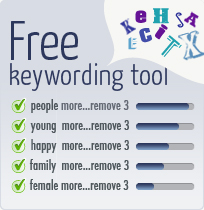 My name is Yuri Arcurs, and for those of you who don’t know me, I’m the world’s top selling stock photographer and founder of www.peopleimages.com. I have spent the last 10 years as a stock photographer and I´ve worked with over 100 stock agencies. Today I’m exclusive with Getty, but prior to that, I distributed to as many agencies as possible. Together with my distribution manager, I would go through a series of analysis for each new stock agency that would pop up to determine whether it would be worth our while to work with them. Back then I only had 40 000 images, but considering the time spent on uploading, categorizing, attaching model releases, etc. it still took months to get the images online. Before making the call to engage with new agencies I´d make a preliminary evaluation of the site’s potential success. Most of the time the assessments we made were right, and I believe part of my success is attributed to not wasting time on the wrong distribution partners.
My name is Yuri Arcurs, and for those of you who don’t know me, I’m the world’s top selling stock photographer and founder of www.peopleimages.com. I have spent the last 10 years as a stock photographer and I´ve worked with over 100 stock agencies. Today I’m exclusive with Getty, but prior to that, I distributed to as many agencies as possible. Together with my distribution manager, I would go through a series of analysis for each new stock agency that would pop up to determine whether it would be worth our while to work with them. Back then I only had 40 000 images, but considering the time spent on uploading, categorizing, attaching model releases, etc. it still took months to get the images online. Before making the call to engage with new agencies I´d make a preliminary evaluation of the site’s potential success. Most of the time the assessments we made were right, and I believe part of my success is attributed to not wasting time on the wrong distribution partners.
Just recently a new player has entered the Stock arena. Adobe launched its “Adobe Stock” which is the biggest entry from a foreign entity that the stock industry has ever seen. On the online communities there are many opinions and ongoing discussions about this newcomer and the impact it might have on the stock industry. Instead of diving straight into the middle of these discussions, I thought I would do something different. Why not put Adobe Stock through the same preliminary evaluation process that we used to perform in order to determine whether or not we would submit our images to them? In the following article I will rate Adobe Stock on a scale from 1-10 on various critical criteria.
 Server Speed Comparison
Server Speed Comparison
(Score: 2/10)
These days, the customer’s expectation regarding server speed is very high. They pretty much expect a loading time that is equal to that of Google, which is not easy to achieve. The first thing I noticed is that the stock.adobe.com website seems slow. At first, I thought the problem might be my connection or geolocation since I live in South Africa. To be sure, I ran it through various site speed testers and the results were quite interesting. The landing page of stock.adobe.com loads very fast, but a simple search for a keyword like “cute” loads very slowly. Repeat searches load quickly, but first time searches take as long as 6 seconds to start loading. In comparison, my own site, peopleimages.com, with a much lower “server budget” than Adobe, scores an average of 65/100 on Google’s PageSpeed Insights on a search for the keyword “cute” for example. Adobe’s stock site scores 52/100 on average. Shutterstock scores 47/100 on average between mobile and desktop users. If you get other results when testing this, share your findings in the comments section below.
Shutterstock.com 47 / 100 (Seems faster than scores dictate however)
Peopleimages.com 65 / 100
Stock.Adobe.com 52 / 100
Conclusion on Adobe Stock site speed: First search so slow you notice it. Second search ok. Not impressed!
Score: 2 out of 10.
 Ease of Sign-up and Purchase
Ease of Sign-up and Purchase
(Score: 1/10)
I logged in to my existing Adobe Cloud account and purchased a subscription for stock.adobe.com as an addon to my current account. To my surprise, it turned out that I had not purchased a subscription anyway and to this day I am still unsure what I actually purchased because I am not able to download anything. To add to this, support was of no help as I was referred to Danish support pages, which had no entries. A highly frustrating experience to say the least. Checkout and customer support are very standardised nowadays so I am sure these issues will be fixed. The puzzling aspect here is why the Adobe team chose to launch their new stock site without sufficient customer support. To me, the launch seems rushed, and the ease of signup and purchase experience seems to have a general lack of attention to detail. Personally, I tested my own site for weeks prior to the official launch date and would never have launched it in the state Adobe has. I believe the reason behind their premature launch is founded in them wanting the product out before the Adobe MAX conference in L.A. on Oct. 3rd 2015.
Conclusion on ease of sign-up and purchase: Sign-up and purchasing is troublesome to put it mildly. However, these issues are easily fixed. What worries me is that they chose to launch anyway.
Score: 1 out of 10.
 Search Result Quality (Score: 4/10)
Search Result Quality (Score: 4/10)
Let’s compare search results. Simple search results for a set of common to not-so-common keyword combinations. Although the results I have listed below speak for themselves, I will go ahead and comment on them for the ease of reading this article and to spare you the trouble of visiting all the links. Keep in mind that these are keyword searches that I have chosen because they are cases where Adobe performs particularly poorly, it is not a fair judgement of quality per se.
About two years ago a similar comparison of search results was done by stock journalist Jim Pickerell, where my site peopleimages.com was compared to shutterstock.com. Jim Pickerell concluded that my site looked the best (hurray), which prompted Shutterstock into immediately optimising their results for the given searches rendering the comparison “fake” or staged. To put a damper on the “quick fix temptation” I´ve linked screenshots of the search results as they appear at the time of writing this article.
Common Keyword: Cute
Results:
Shutterstock.com – Accurate result, but pretty much only vectors and illustrations. Not ideal at all.
Peopleimages.com – Accurate result, but only a few images due to quality cutting.
Stock.Adobe.com – Very outdated and mediocre images. They are even serving some of the exact same images as Shutterstock on the first page. By exact, same I mean identical.
Rare Keyword: Retrenched
Results:
iStockPhoto.com – Very accurate result for a pretty rare keyword. iStock has been known to uphold a strict policy of correct and accurate keywording towards its contributors.
Peopleimages.com – Accurate result, but only a few images.
Stock.Adobe.com – Exceptionally unsatisfying result. With more than 30 million images to source from, the 29 images that come up are disappointing to put it mildly. People with army helmets and machine guns have nothing to do with being fired, and there are fair amount of them below what is shown in the screenshot.
Natural Language Keyword Search: Being Entertained
Results:
iStockPhoto.com – 200+ images. Result is not bad actually, taking into consideration that we are now looking at some very difficult searches.
Peopleimages.com – I must be honest and admit to a somewhat unsatisfying result here.
Stock.Adobe.com – Quite humorous and completely disconnected search result. There is pretty much nothing here that makes sense. From tomatoes and babies to grannies with massive laptops and hippies eating topless in a kitchen. The only thing to say about this search is that I was most certainly “being entertained” by looking at the results, but we are definitely not finding images of people that are actually being entertained.
Another issue to discuss while on the topic of search results is that Adobe Stock does not allow me to search in English. It keeps giving me zero results and forces me to search in Danish. I believe my Adobe account has it’s billing address set to my Danish company, but even if I logout the site simply won´t allow me to search in English. Does this mean I´ll need to change my billing address to an English speaking country and delete some cookies or? I can only imagine the desperation of design teams around the world who, in order to use Adobe Stock, will be forced to search for images limited to the language of the billing address 🙂
Conclusion on search result quality: Highly unrefined search engine that needs a lot of TLC and desperately needs new and modern images to compete convincingly. In the spirit of how this test was done I will still give Adobe Stock a solid 4, since some searches returned decent results.
Score: 4 out of 10
 Photographer Royalties (Score: 2/10)
Photographer Royalties (Score: 2/10)
Adobe’s 33% flat rate in photographer commission reminds me of 2005. Literally nobody in the industry works with a flat rate royalty structure anymore, not even the agency that Adobe bought (Fotolia). If you want mediocre images, flat rate commission is great, but if you want excellent photography, you need to give more to the ones that go the extra mile and produce images that are more expensive, more competitive, more interesting, higher resolution, and higher selling. If an agency decides to give these photographers the same commission as everybody else, it is the same as saying that they don’t care about dedication, or at least that they don’t want to pay for it. Bad idea.
However, I’m pretty sure it won’t stay like this. The 33% commission is probably the biggest misunderstanding in the Adobe offering and I simply think it is an overlooked aspect right now in favor of higher priority issues. A commission of 33% is exceptionally low in microstock and most agencies have top tier commissions into the 40%+ range. This leads me to believe that the reasoning behind the low commission is either that it is “coming soon” or that Adobe really wants to make money on their new project. If the royalty rate of 33% is not a “mistake” or “to be defined later” then we need to seriously upgrade our thoughts on Adobe’s ambition here. Then they are setting out to make serious money, take a huge chunk out of the stock industry and be a big player.
Conclusion on Photographer royalties: I think there is a pretty good chance that we can use this 33% flat rate decision as good indicator of initial ambition, even if it’s changed later on. Adobe wants to make money, right now… and takes on a “too simple” and “too low” royalty structure.
Score: 2 out of 10.
 Pricing (Score: 10/10)
Pricing (Score: 10/10)
With single images costing as little as 5USD, and mini subscriptions of 10DL per month for 30USD per month, Adobe is placing themselves in the lowest price category we have ever seen from a “serious” agency. This kind of price point only makes sense in ultra high volumes, and since they are serving the exact same non-exclusive images as Shutterstock, the strategy appears to be clear here. Adobe Stock is not trying to take customers away from higher priced agencies such as iStock and Getty, they are trying to underprice the “underpricer” (Shutterstock) and simply convert its customers to Adobe Stock. It is ironic for me to have been part of an industry for more than 10 years now that got the nickname “micro” stock, and now witness a new competitor entering the scene 10 years later with a pricing strategy that aims to underprice microstock. What are we to call this? Nano-stock?
Regardless of whether we believe in this “low-price strategy” or not, we have to accept that the offering is extremely competitive. The only problem they will face selling images this cheaply is getting new images, because at these prices photographers make so little, that they can’t afford to produce new content.
Conclusion on pricing: Adobe is going for an aggressive low-price strategy that aims directly at taking customers away from Shutterstock, Depositphotos, Dreamstime and similar microstock sites, but less from higher quality/higher priced sites. As photographers we might not agree with this strategy, but for customers, this might just work out to be a great solution to supply their “basic” image needs.
Score: 10 out of 10
 Usability and Search Functions
Usability and Search Functions
(Score: 2/10)
What search functions? Adobe Stock has five basic search expansions in the sidebar and they are by no means convincing. The industry is way beyond that. On peopleimages.com you can search for countries in the fashion of “Norwegian girl” and get images that are rated by Norwegians as looking Norwegian. You can search for looks, for copyspace placement, for clothing type, body type and the list goes on. Also keep in mind, my site is not the only one with highly advanced search functions. On iStock you can search for copyspace in a manner that is even more refined than on my site. While these search functions are rarely used by customers, they are loved dearly by the types of customers that use stock images frequently. These customers represent a small percentage, but they buy a lot!
Conclusion on usability and search functions: Not impressed by search functions at all. Way behind industry standard. Even for a first launch.
Score: 2 out of 10.
 Marketing and Future Potential (Score: 8/10)
Marketing and Future Potential (Score: 8/10)
The Adobe offering is nowhere near ready for a big marketing push or spending millions on Adwords, which it seems they are currently doing. My site was also spending a lot on Adwords up to a few months ago when Adobe launched, and the price per clicks suddenly became so high that it made no sense to do so anymore. So somebody is spending a lot, and it is most likely Adobe. In the current state of their site, I believe it is money right down the drain. That being said, Adobe has a lot of it and can push marketing to an extreme that the industry simply cannot keep up with. Nobody in the stock industry would be able to financially keep up in advertising spend should Adobe decide to push hard. This is rather scary. Particularly because Adobe Stock will not stay as unrefined and unpolished as it is now. Most of the problems we have identified are all fixable and will probably be fixed in the not so distant future.
Conclusion on marketing and future potential: Adobe has a huge brand that every creative person in the world knows. It has deep pockets and they are probably already putting that to use from the increase in Adwords prices since their launch. I believe they are spending money prematurely on Adwords marketing, but they can afford it.
Score: 8 out of 10
Overall Conclusion – A rough start for big ambitions
(Overall Average Score: 4.1/10)
So to answer the question “Would I, back in the days, have distributed my images to this agency?”, the answer based on the above evaluation would be a definite “no”. If this new agency was anyone other than Adobe, I would not have considered joining the site. However, it is Adobe, and it is unlikely that the issues highlighted above won’t be fixed over time.
The only problem that is not easily solved is image quality and in this regard, I will put my head on the block and claim that Adobe bought the wrong agency (Fotolia) to get into the market. My own customers on peopleimages.com are often complaining that shutterstock.com and fotolia.com looks outdated and refer to the images as looking “old”, “bad”, “too similar” and too heavily populated by cartoons and vectors. Peopleimages.com is doing better than ever exactly because of this quality drop and my iStock and Getty sales are on the rise for the same reason. By purchasing fotolia.com Adobe got themselves one of the biggest collections of mediocre images the world has ever seen and now they must find a way to deal with it. It´s pretty clear to me that Adobe got themselves a really bad deal in spending 400mil USD on Fotolia.com and with my customers feedback in mind about disliking an outdated look, I believe they have a much bigger problem than they think they have.
While analysing Adobe’s entry into stock it’s worth mentioning that Shutterstock offers the exact same images as Adobe Stock (and I mean identical). They offer the exact same type of subscriptions and single image download models. Shutterstock is finding themselves face to face with Adobe like no other stock agency out there. They even acquire customers the same way, using millions on Adwords and SEO, except now Shutterstock has a bigger brother, with deeper pockets. I see Shutterstock as potentially the biggest loser from the entry of Adobe Stock and it seems to show already since their stocks have dropped so low that if they go just a tiny bit lower, Jon Oringer will no longer be a member of the billionaires club… ouch.
Another problem Shutterstock is facing is that unlike Getty, Peopleimages, and iStock they don’t have a distinctive look nor do they have exclusive images as a selling point. To make things worse, every single buyer of a Shutterstock image loads that image into an Adobe program at some point. Adobe basically has their straw straight down into Shutterstock’s customer list. So if Adobe decides to, they can entice their users to sign up with Adobe Stock and make it very attractive to discard any Shutterstock subscription. What do you think will happen when the avid Photoshop user starts experiencing small in-program suggestions to join Adobe Stock with offerings that are cheaper than Shutterstock for the same images? Let’s face it, Shutterstock is replaceable but there is no other viable alternative to Photoshop, InDesign, Illustrator, etc.
I think Adobe will get around the initial IT hiccups pretty fast and do quite well. The defining moment for when I would consider Adobe dangerous in terms of impact on this industry is when they solve two major problems: a) Image quality and b) Photographer commission and ultimately quality of submissions. That would also be the point in time when Adobe could start pushing Adobe Stock via their product line, primarily through Photoshop and Illustrator. The photographer commission structure that gives more royalties to better photographers, is an easy fix. The image quality problem is a much bigger issue.
I believe Adobe think they have an idea about how to fix the image quality problem: They would probably think that they could use the Adobe product line to push for photographers to make submissions via their applications (i.e. directly through Photoshop). They would use this to gain access to new photographers and new content that was currently not associated with stock photography and build a unique collection that way…
STOP RIGHT THERE… That is not going to happen.
There are no decent photographers in the world that don’t know what stock photography is and haven’t tested the waters already. The barriers of entry are the same for submissions via Adobe Photoshop as they were back when they tested the waters. Images still have to have model releases, have to be keyworded and retouched. It is not because photographers do not know about stock photography that they don’t submit images, it’s because it is heavily time consuming to do so, and to make things worse, images are often rejected because of quality issues. Submitting directly through Photoshop (if that was to become an option) is no different and Adobe will be unpleasantly surprised about the quality of images coming through that channel and the actual impact they will have on sales.
Adobe needs to look outside the range of their new pet, Fotolia, to actually find good enough images to stand out and that is not going to be easy.



















Wow, that is one of the most biased reviews I have ever seen. 33% flat royalty is too low? How about the outrageous royalties istock has that are 15%? 33% is pretty much the highest in the industry for sites that actually make photographers money. Shutterstock has a 30% flat rate royalty for things other then subs. It is obvious you feel threatened by adobe stock and have your own business interests to look out for, which is totally fine, everybody is entitled to make a living, but please do not put out such biased misinformation. Adobe buying Fotolia has been one of the most positive developments in microstock for a long time. In an age of no transparency, ever declining revenues and disdain for contributors from the top, Adobe Stock/Fotolia really stands out of the pack. Especially considering all the reaching out Adobe has been doing with photographers recently.
What other agency lets you have one on one attention from the people who run it? What other agencies actually have a presence at trade shows and expos and are actively working towards helping their photographers succeed? The truth is the big players are terrified of Adobe and are clueless on how to compete with them.
As a photographer I have never earned as much as I do with Shutterstock. And I’m not speaking about some cents: I am making a living EXCLUSIVELY with microstock.
I’m paying my debts and one day I’ll be able to afford STOCK (not micro, not nano).
Some time ago you were prophetizing your ideas about mobile stock … and it doesn’t seem it is becoming true. I stopped very quickly with scoopshot and their brothers.
What has to be done is increasing reviewers photographic and graphic culture. Sometimes technical problems like grain are NOT important in front of a very good photograph. Good photograph can’t be judged for 4 dollars a hour.
I can moan lowns for far more. Selecting beauty means knowing beauty.
Every marketer knows that SELLING comes first. Even before WHAT do you sell and its quality. The best SELLER wins.
And you know it perfectly, crafty old devil 😉
The summary is such that you have said, Adobe is Adobe. As a Fotolia contributor (among other agencies as Stocksy, Shutterstock, iStock …) I trust fully in the union of these two forces. The potential market where Adobe Stock moves is immense and I am convinced that they will get good results.
Hi Josh.
Biased? Where? Don’t just say such things. Back them up.
Royalties. I am currently getting 40% at iStock and have my eyes on 45% in the near future. That is a heck of a lot better than 33%. If you are somewhat good exclusive photographer with iStock you can 40% no problem. Not with Getty, because they sell each and every image over the phone basically and that is not cheap which is why they offer 10-15% less in royalties than other sites. Comparing GI to micro sites is not comparing apples to apples.
I agree that Fotolia being bought was one of the most positive things that has happened to the industry as a whole, but that is not the same as saying that Adobe bought it at the right price or perhaps should have bought something else. Don’t confuse the two.
I agree 100% with your last paragraph. Well put. (remember that the big players includes shutterstock)
Yuri, I get the feeling that the grass wasn’t greener on the other side after having gone exclusive with Getty. I know you probably won’t tell us about your income nowadays compared to back then, but I think we all know that it’s nowhere near what it was.
Adobe/Fotolia is not evil.
IS/GI is evil. Period.
We all know this well.
Hi Master of Coin….
You asked if I dropped in income after becoming exclusive with iStock. The answer is yes. Initially I did and it took me close to a year to reach good sales with iStock and Getty, but I must admit to being very happy with the income where it is now. I did expect a drop in the start, but I also became exclusive because I felt I had good data to support that I could get a higher income down the line and that iStock/Getty would do better over the years and was at a low point. If I am to be completely honesty it was a risky move, but my philosophy on such matters has always been to look at the bigger picture, and do what seems to make sense even if you have a loss in the start. Back in 2005 I put all my production into microstock, at a time when people where literally yelling and screaming about it being complete madness to be part of. That paid of big time. Now people are yelling and screaming online that going exclusive with iStock is not a good idea financially. My idea has always been to be 2-3 years ahead of the popular belief, and I am pretty sure I am right this second time around again 🙂
The golden years in terms of income per image for my company was in 2011, and I don’t think the industry will ever reach those levels again. The golden years in terms of total earnings are now actually AND profits are much higher than what we had in 2011 because of better management of staff and smarter shooting. I will most likely have the best year ever either this year or next year. Depends on Nov and Dec sales this year.
Take no notice Yuri! Don’t belittle yourself with any involvment with the MSG crowd, just jealousy and depression little people.
On track: myself and many established friends in this business are in fact doing extremely well with Adobe/FT! revenues have skyrocketted some 200% the agency/contributor communication is the best in the business.
Simply can not fault this partnership in any way. So, servers are a bit slow, well all agencies servers are slow. No big deal really.
I can respect a dialog and thanks for responding Yuri. I have been exclusive with iStock in video/photo since 2006. I am a diamond level video artist stuck at 35% and I don’t see that changing. I hear Adobe is going to sell video as well. Do you shoot video? My sales at iStock are lower by about 10 grand this year compared to last year. Getty sales are always lower then iStock on income. If Adobe pays 33% to video artist and charges $80 per clip but bring in a lot of buyers they could be a real threat on the video side. Can you address the iStock improvements? The site is still buggy and very slow at times, I am frustrated by that. It seems to me Adobe is thinking on how to improve while others are think how to limit their loses. How about the new CEO? In the video she mentioned taking care of artist but just what dose that mean? Since you feel Getty is the path forward I would like to know your reasons why. Thank-you
Hi Lagereek.
I agree that the partnership between Adobe and Fotolia is fruitful and scary to agencies like Shutterstock and iStock. Happy revenues are up, they are up on my side as well on IS. Not hearing so much about shutterstock, but perhaps we will see later. I don’t like the price point Adobe is selling at and I don’t think it does anything good to the business. Too low.
Agree in regards to MSG as well. Sad to have to say goodbye to what was once a good forum, but now dominated by trolls and unrefined criticism towards basically all establishments. I invited all of them to put their critical comments into real arguments and post them here and I would gladly respond. Guess how many showed up… Not one… Happy to trash talk, but not to stand up for it.
While MSG is overly critical and I don’t post much there, at times they call it like it is and at times not. I am happy for any deal you can get or make but the majority can not. You have worked smart and hard to get where you are but don’t let your success blind you the the reality of the majority. You just gave Adobe a free analysis. I find the server speed a non issue. Quality of search not as good as iStock/Getty but decent and no worse then ShutterStock. The real question is do buyers care enough about exclusive content to keep the iStock model feasible for artist.
Well its not even trolls anymore, bar a few its just ppl who have failed in micro-stock and have found a new hangout where their failure is stock won’t be noted.
look behind the pseudos!! its the same old ppl, writing the same old misery. nothing else to do.
Adobe is as you know a very powerful and dynamic name in the creative world. So far this partneship with FT has proven they are doing something.
Take a look at SS, they are doing nothing, their main concern is just trying to satisfy share-holders, resulting is short-term profit thinking strategy which of course in the long run it completely detrimental.
As far as GI, well I am a member there since the good old days, since 95, it was brilliant, earning fortunes but I have to say, nowadays they don’t seem to come up with any more answers or ideas. Maybe its yet to come?
all the best.
Hi Yuri,
Interesting analysis. Given the criteria you are using above, which would be the top 10 stock libraries today on this basis?
Joseph
Lots of talk about royalties here. ImageBrief pays 70% to non-premium members and 100% to Premium Members. Can’t get better than that.
I would also add that Adobe/FT together with SS and of course the RM industry, is still highly worthwhile supplying stock of High-commercial-value. Its paying off all the time.
Myself and most of my friends and colleagues are basically assignment photographers working on commissions for Ad-agencies, corporations, etc, which means that you have already invested in best possible equipment, lighting, medium-format digital, etc and thats regardless of stock-photography so unless travelling to shoot stock, there are no outlays, expenditures.
This fact alone puts you right in front of the ordinary competition.
Only a few weeks back, I did a shoot for Shell-Oil Corp in Scotland, supplied 6 pictures only, 28Mb jpg size, already three enhanced-License sales and numerous credit-sales. This shoot costed me nothing since it was commissioned based.
Two of these came in via Adobe/FT, so its well worth it.
best.
Very interesting read, some valid points. But some are off.
No wonder your conclusion in this article to not upload. This is because you are exclusive. How big was your percentage at iStock back in the days? Probably 20% ? Abobe offers way better rate of 33%.
You review Adobe Stock as independent agency. But it is not. If you are contributor to Fotolia you are automatically contributor to Adobe Stock. There is no way to upload to Adobe Stock directly.
So the question is this article should be “Would I, back in the days, have distributed my images to Fotolia?”.
I you don’t like Adobe Stock you would have to stop distributing through Fotolia as well.
But being independent your cannot afford to loose such big chunck of revenue.
Selection of search keywords is very very questionable. How many actual buyers are searching for Retrenched, Cute or Being Entertained? And what percentage of those searches will actually lead to sale. This keyword list is not representative.
MSG isn’t great but is there a better place to keep in touch with what’s going on in microstock? I stopped looking at MSG for a year, mostly because of people like lagereek who were just trolling it. I went back because there’s enough useful posts amongst the pages of nonsense to make it worth looking at.
As for adobe, I think FT was a bad brand and I have no idea why they didn’t just start their own site. Having not uploaded to FT in such a long time, I’m inclined to give it a year and see if adobe can make a big difference.
Yuri, I just can’t take your article seriously, to submit to Adobe you would have to drop the istock crown and would be back to 20%. So if adobe get a 2/10 for commission, istock would be a 1/10. Nobody who wants to make the most money from their portfolio would go exclusive with adobe, so you really need to compare the sites non-exclusive commissions. The vast majority of non-exclusive contributors get less than 20% with istock and I think that was an important psychological barrier. I don’t visit istock any more, removed most of my portfolio and just get a payout every now and then. Less than 20% and falling sales volume killed my enthusiasm. I’m sure GI would make more money if they went back to a minimum 20% at istock but they wont do that.
Yuri, thanks for taking the time to research and express your opinion on this subject. Here is my take on it.
I work in broadcast television – mainly sports – and Getty Images (stills) are used daily (on a subscription), but it’s all editorial. For video the producers don’t bother searching Getty or iStock, it is always Shutterstock or Pond 5 and they are rarely disappointed.
I can only speak of my experience supplying stock footage to iStock, Shutterstock and Pond 5. My Shutterstock revenue has risen 1000% over 6 years and Pond 5 by 450%. iStock revenue has dropped by 30% although this is due more to lowering of commission by the Getty group rather than a drop in sales (which remains steady). Note I am not a full time stocker.
How this scenario will be affected by Adobe/Fotolia I don’t know – I withdrew from Fotolia many years ago – but I think your opinion on what Adobe’s plans (needs?) to do are spot on.
I believe there is no right or wrong solution to selling (micro)stock and different combinations work for different people as you have found and very few will have a catalogue as copious and good as yours.
My advice is if you are not 100% happy with your income then try adding another outlet for a period. Going down the exclusive route is a risky bet and one few are willing to make especially as the rewards are not always worth it.
Regards.
what do you think about alamy?
Well – Adobe already failed once, when they tried to integrate Stock imagery with Adobe Bridge and then quietly removed this feature… And they failed many more times, delivering products far from perfection (remember firs InDesign?)… But honestly – who didn’t fail? Let’s look at the biggest names: Apple – check, Microsoft – check… That two examples should be enough. But Adobe (as well as Apple or Microsoft) are improving. So sooner or later they will become a very strong competition. So I get your points (though some seem not 100% objective and also more seller than buyer oriented), but I guess they will find a way.
Remember that MAJORITY of designers are on tigh budgets and they are more quantity than quality oriented. I feel you – because I also prefer to do less quality work, than a lot of average stuff, but that’s just a small percentage of the total market. So there’s always need for cheap stuff.
I think we will see some quality pictures getting cheaper – the new and trendy stuff will kepp the high price tag, but pics also have their expiration date. Some models are too popular. Some shots quickly loose their “new” factor. And those will be the pics that will draw customers to Adobe.
Yuri,
Thanks for the information. As busy as I am it is hard to research the information that you provided here. Very helpful, as always!
Todd
Thank you for your post on this. I am thinking about entering this market and I appreciate seeing how you judge a stock photo agency. Nice post, and a lively (if a bit cranky) comment section.
I’m excited to uncover this website. I wanted to thank you for ones time for this particularly fantastic read!!
I definitely loved every part of it and I have you book marked to see new information in your blog.
Wow! This can be one particular of the most beneficial blogs
we’ve ever arrived across on this subject. Basically Magnificent.
I’m also a specialist in this topic therefore I can understand your hard work.